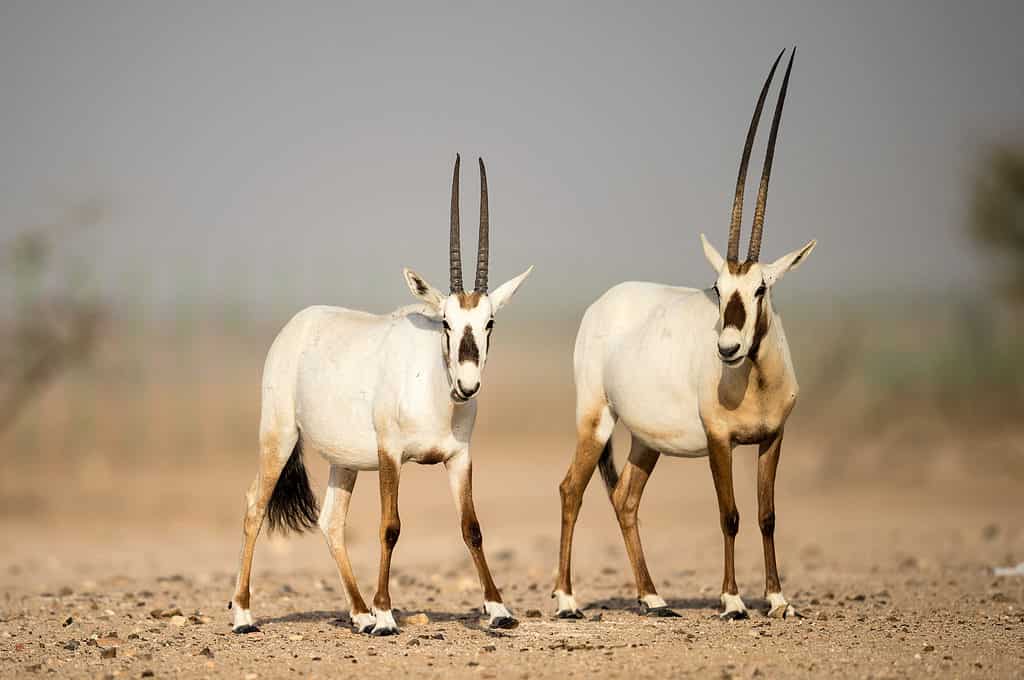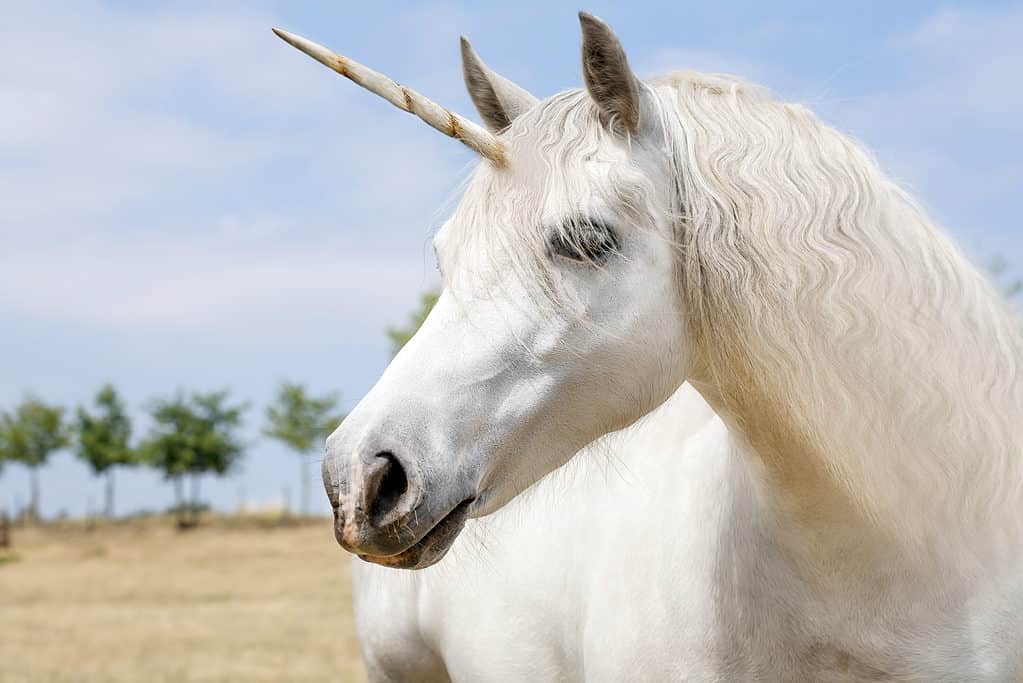The world is witnessing the excitement of one of the most popular events – the FIFA World Cup. In 2022, it takes place in Qatar. Naturally, all eyes are on Qatar. However, there is more to this country than just world-class football. Did you know that Qatar has its own national animal? The Arabian oryx is native to the Arabian Peninsula. This majestic creature is remarkable for its intelligence, grace, and beauty. In this article, we will learn about the fascinating Arabian oryx, Qatar’s national animal.
Discover The Arabian Oryx

The Arabian oryx has long black-tipped horns and a slender figure.
©Max Earey/Shutterstock.com
The Arabian oryx, or white oryx, is a medium-sized antelope that inhabits the desert regions of the Arabian Peninsula. It has a thick white coat, long black-tipped horns, and a slender figure characterized by large eyes and ears.
This agile animal can run at speeds of up to 50 mph and jump over obstacles up to 8 feet tall!
Taxonomy Of The Arabian Oryx
Kingdom: Animalia
Phylum: Chordata
Class: Mammalia
Order: Artiodactyla
Family: Bovidae
Genus: Oryx
Species: O. leucoryx
Size and Color
The Arabian oryx stands between 3.5 and 4.2 feet tall, with a body length of up to 6 feet. Its horns can grow up to 24 inches long. It has a white coat with black markings around the eyes, mouth, and legs.
Habitat and Range

The Arabian oryx’ habitat ranges from steppes and wadis to deserts and mountains.
©Nimit Virdi/Shutterstock.com
The Arabian oryx is nomadic, moving with the changing seasons to find food and water. Its habitat ranges from steppes and wadis to deserts and mountains.
While it can survive periods of extreme heat, it is also capable of adapting to temperatures as low as -4°F. The Arabian oryx is found in the wild in Oman, Yemen, and Saudi Arabia. The Qatar government has also successfully introduced the species to Qatar.
Diet and Behavior
The Arabian oryx is primarily a grazer, feeding on grass, shrubs, and herbs. It can extract water from the plants it eats, allowing it to survive in the dry desert climate in Qatar. This animal can also go for long periods without water and can eat plants that are toxic to other animals.
The Arabian oryx is a diurnal animal that is most active during dawn and dusk. This is when they go out in search of food and water.
During the hottest parts of the day, they will find shelter in shady areas and rest. When threatened, the Arabian oryx has a unique defense mechanism – it forms a semi-circle and displays its sharp horns.
Social Habits
Arabian oryxes are social animals that live in herds of up to 10 individuals. The herd is led by a dominant male, with the other members consisting of females, calves, and subadult males. The herd is generally quite territorial, with the dominant male marking their territory by urinating on rocks and plants.
Arabian oryxes also have a unique way of communicating with one another. They whistle, hum, and sometimes even snort to convey their feelings or intentions. If threatened, they will often snort loudly to alert others of danger.
When it comes to mating, Arabian oryxes are quite promiscuous. Mating occurs throughout the year, and the dominant male mates with all the females in his herd. The female will give birth to a single calf after a gestation period of eight to nine months.
Caring for Calves
Females are very protective of their young. The mother remains close to her calf, grooming and cleaning it, for the first few weeks. She will also teach it to search for food, as well as how to protect itself from predators. After a few weeks, the calf will be able to fend for itself and join the rest of the herd.
The Arabian Oryx Used To Be Extinct In The Wild
The Arabian oryx was driven to extinction in the wild due to overhunting. This majestic animal was a popular hunting target for centuries. Despite several attempts to protect it, the species was declared extinct in 1972.
The Arabian oryx also suffered from loss of habitat due to increasing human development. The desert regions were rapidly converted into agricultural land, leaving little room for the species to survive.
Conservation Efforts
Fortunately, the Arabian oryx was not doomed to extinction forever. A small group of captive-bred Arabian oryx was established in the 1960s. This population would eventually form the basis for reintroducing the species into the wild.
The first successful reintroductions were conducted in Oman and Saudi Arabia in 1980 and 1982, respectively. Since then, the Arabian oryx population has grown steadily. In 2011, the species was declared to be “recovering” by the International Union for Conservation of Nature (IUCN). There are currently around 1100 Arabian oryxes in the wild.
To ensure that these animals could survive in their new environment, the reintroduction was accompanied by several conservation efforts. These included habitat protection and management, population size and health monitoring, and anti-poaching measures.
Importance In Qatar
In 2008, the Arabian oryx was named the national animal of Qatar. It has since become a symbol of pride for the country. The country recognized the success of the conservation efforts that had allowed the species to re-establish itself in the wild. In addition to its cultural and aesthetic value, the Arabian oryx is vital for Qatar’s drylands ecosystem.
The Arabian oryx plays an essential role in the food web of Qatar, providing a source of nutrition for predators. The species is also a keystone species, meaning that its presence is essential for the survival of other desert species.
The animal’s importance was highlighted when the country was chosen as the host for the 2022 FIFA World Cup.
The Arabian oryx has become a symbol of Qatar’s commitment to conservation and environmental protection. Qatar continues investing heavily in conservation efforts to ensure that the national animal can thrive in its natural environment.
Arabian Oryx and the Unicorn Myth

The long, straight horns of the Arabian oryx may have inspired tales of a magical unicorn with a single horn.
©Marben/Shutterstock.com
Some historians say that the unicorn myth originated from the Arabian oryx. The long, straight horns of the Arabian oryx may have inspired tales of magical creatures with a single horn.
When you see one in its natural habitat, it’s easy to understand why it has been captivating for centuries. With its long, elegant neck and horns, it has a majestic, almost mystical presence that draws you in.
The Arabian oryx is a unique animal, and its beauty and grace have intrigued people for centuries. It is not hard to see why so many cultures have attributed mythical properties to this animal.
This iconic creature has been part of Middle Eastern mythology and folklore for centuries. It has inspired both awe and fascination in people worldwide. As a symbol of strength and resilience, Qatar hopes to embody its essence as it hosts the 2022 FIFA World Cup.
Up Next
- How Fast Are Reindeer? Are They Faster Than a Horse?
- The 10 Most Amazing Desert Animals
- 6 Incredible Survival Skills Animals Use to Live in Deserts
- The Oldest Desert in the World and 3 Exotic Creatures Living There
The photo featured at the top of this post is © Kertu/Shutterstock.com
Sources
- ITIS.gov, Available here: https://www.itis.gov/servlet/SingleRpt/SingleRpt?search_topic=TSN&search_value=625181#null
- Photos.com, Available here: https://photos.com/featured/arabian-oryx-and-the-myth-of-the-unicorn-joe--clair-carnegie--libyan-soup.html
- Alabama Safari Park, Available here: https://www.alabamasafaripark.com/conservation/news/unicorns-not-quite-meet-the-arabian-oryx-babies
FAQs (Frequently Asked Questions)
How many Arabian oryxes are there in the world?
There are roughly 1,200 Arabian oryxes left in the world and another 6,000 to 7,000 in captivity.
Why are Arabian oryxes endangered?
Overhunting led to this beautiful species becoming endangered. In fact, Arabian oryxes were extinct in the wild in 1972. However, conservation efforts led to the gradual reintroduction of this species to the wild.
Do oryx horns grow back?
No, oryx horns do not grow back when cut off.
Which country has the most Arabian oryx?
Currently, the United Arab Emirates has the most Arabian Oryx. But this species has also been introduced to Qatar, Bahrain, Palestine, Jordan, and Saudi Arabia.
Thank you for reading! Have some feedback for us? Contact the AZ Animals editorial team.






